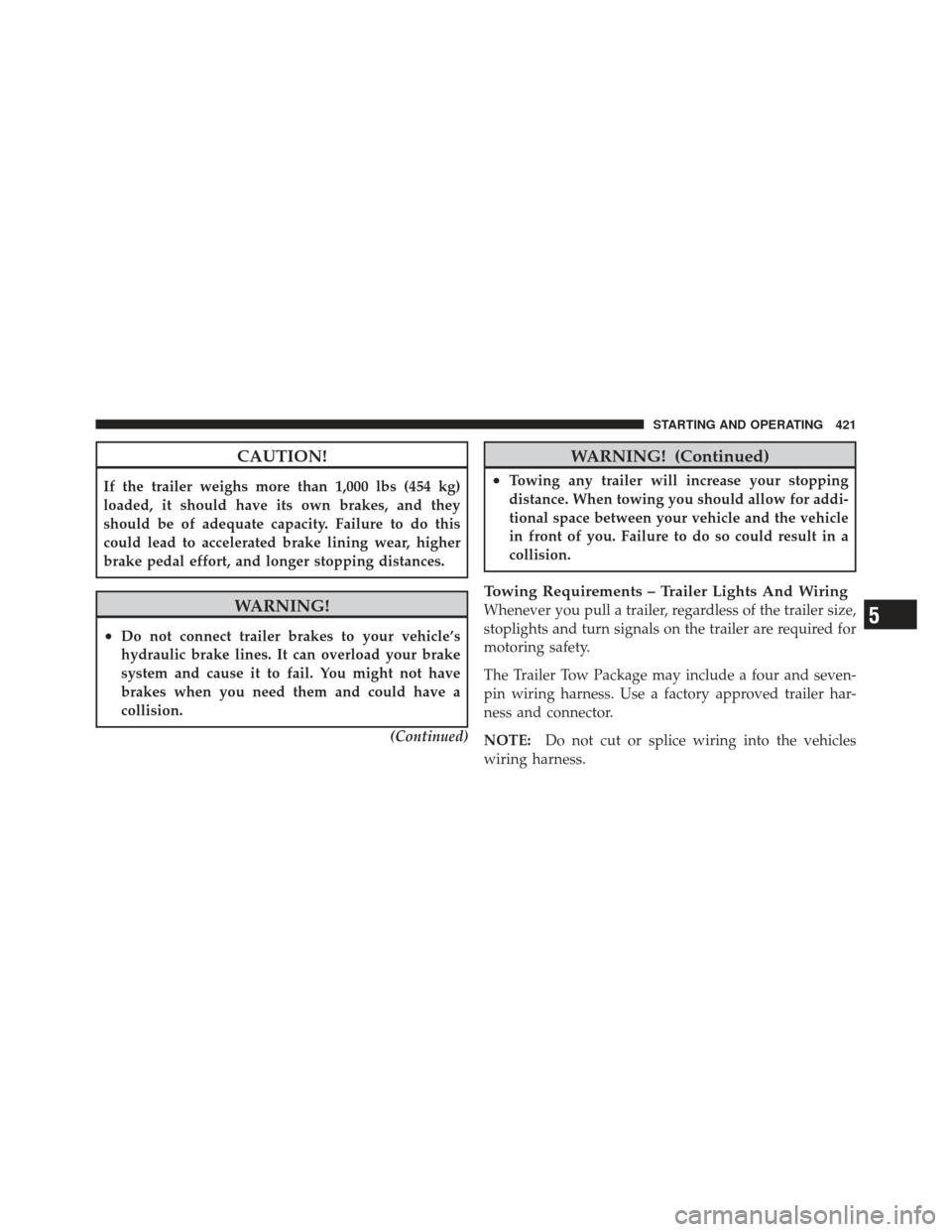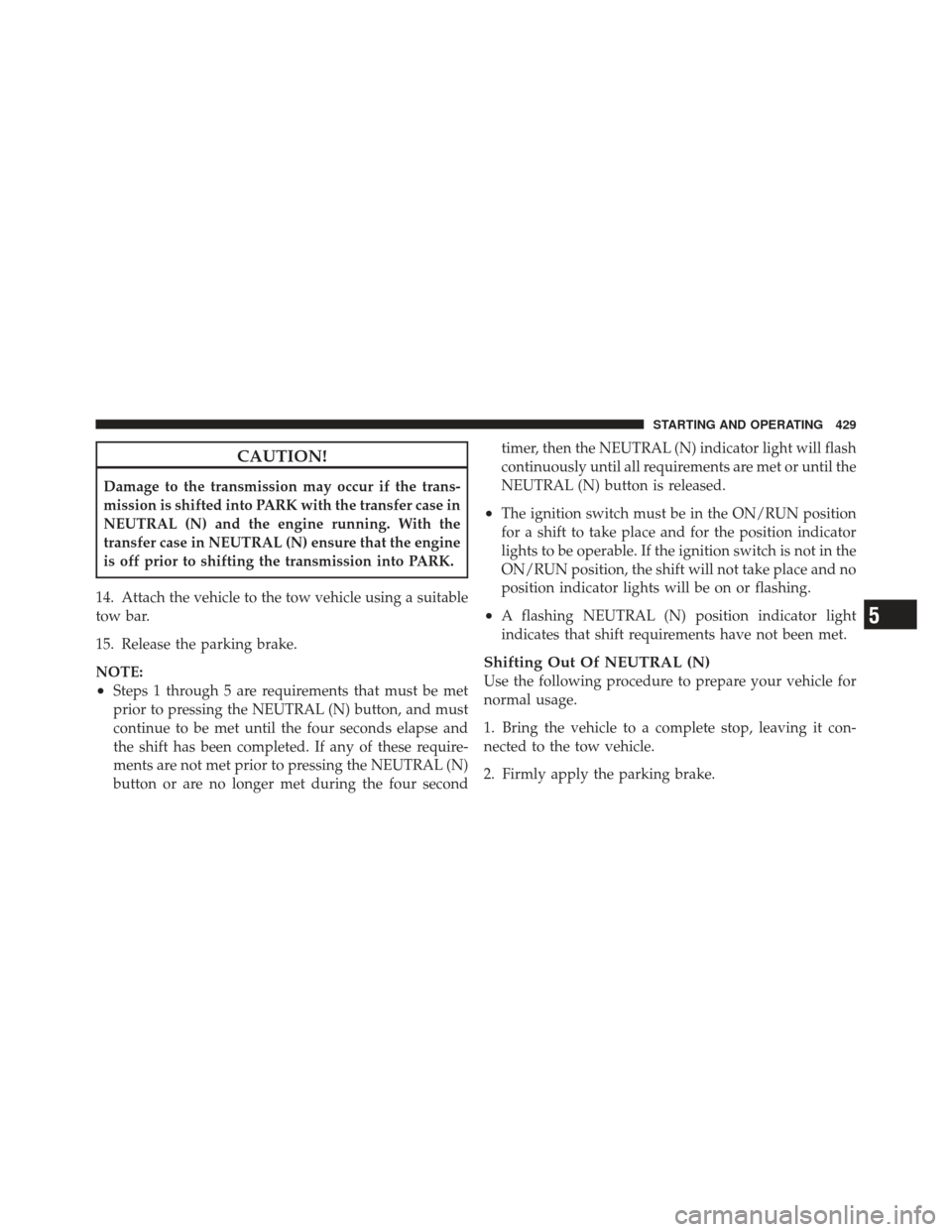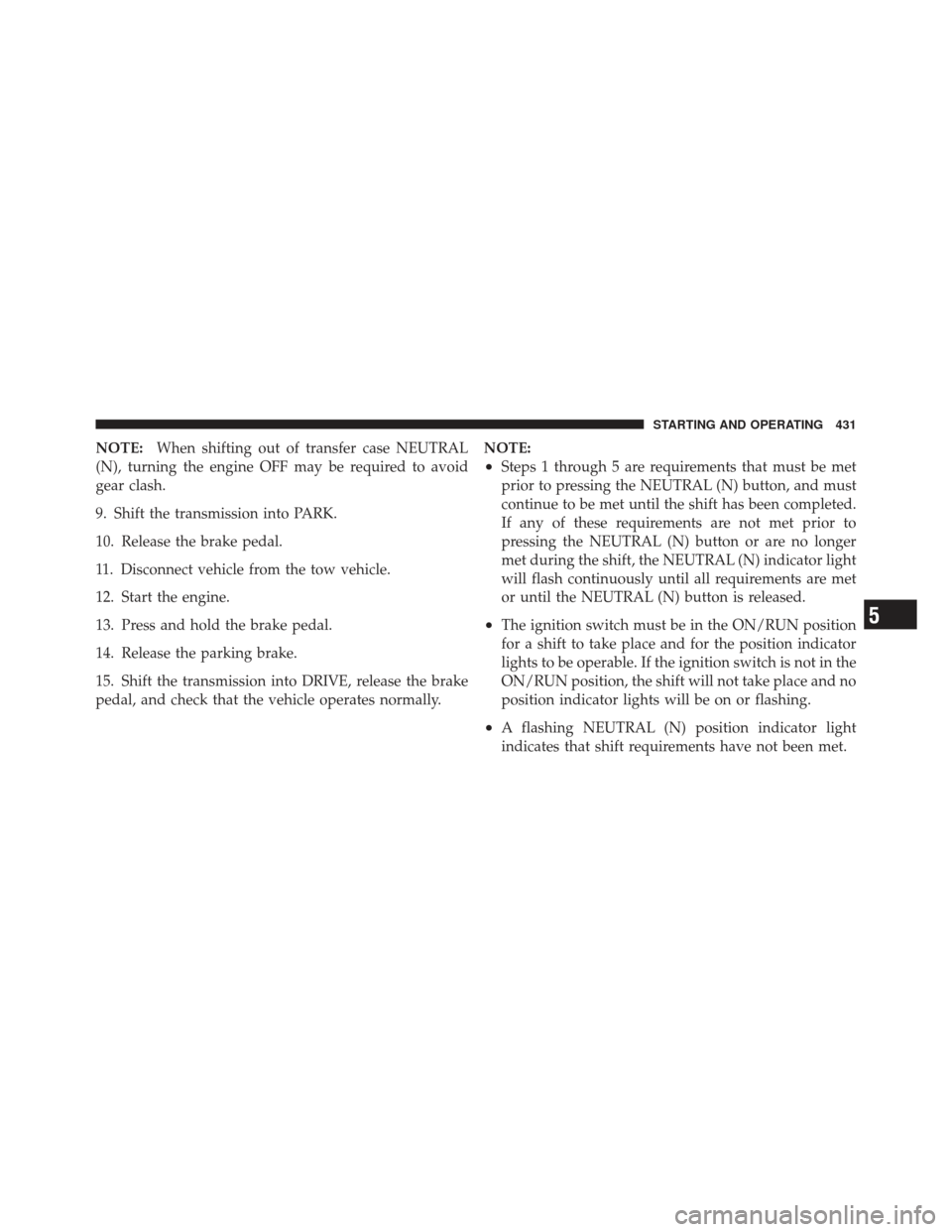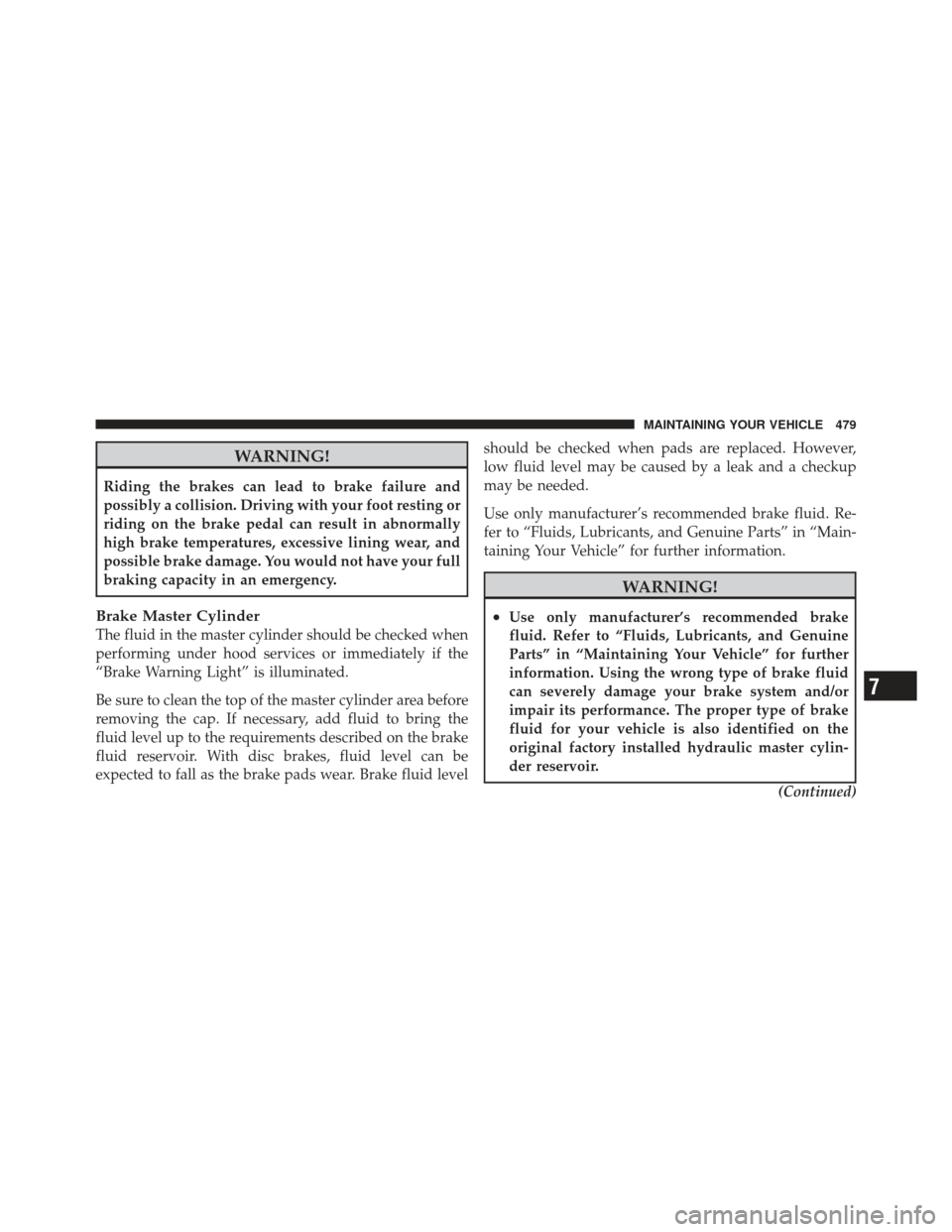Page 365 of 558

2. Press the “Hill Descent” button. The “Hill Descent
Control Indicator Light” in the instrument cluster will
turn on solid.
NOTE:If the transfer case is not in 4WD LOW range,
the “Hill Descent Control Indicator Light” will flash for
five seconds and HDC will not be enabled.
Disabling HDC
1. Press the “Hill Descent” button or shift the transfer
case out of 4WD LOW range. The “Hill Descent Control
Indicator” light in the instrument cluster will turn off.
Electronic Stability Control (ESC)
This system enhances directional control and stability of
the vehicle under various driving conditions. ESC cor-
rects for oversteering or understeering of the vehicle by
applying the brake of the appropriate wheel to assist in counteracting the oversteer or understeer condition. En-
gine power may also be reduced to help the vehicle
maintain the desired path.
ESC uses sensors in the vehicle to determine the vehicle
path intended by the driver and compares it to the actual
path of the vehicle. When the actual path does not match
the intended path, ESC applies the brake of the appro-
priate wheel to assist in counteracting the oversteer or
understeer condition.
•Oversteer - when the vehicle is turning more than
appropriate for the steering wheel position.
•Understeer - when the vehicle is turning less than
appropriate for the steering wheel position.
The “ESC Activation/Malfunction Indicator Light” lo-
cated in the instrument cluster will start to flash as soon
as the tires lose traction and the ESC system becomes
active. The “ESC Activation/Malfunction Indicator
5
STARTING AND OPERATING 363
Page 423 of 558

CAUTION!
If the trailer weighs more than 1,000 lbs (454 kg)
loaded, it should have its own brakes, and they
should be of adequate capacity. Failure to do this
could lead to accelerated brake lining wear, higher
brake pedal effort, and longer stopping distances.
WARNING!
•Do not connect trailer brakes to your vehicle’s
hydraulic brake lines. It can overload your brake
system and cause it to fail. You might not have
brakes when you need them and could have a
collision.(Continued)
WARNING! (Continued)
•Towing any trailer will increase your stopping
distance. When towing you should allow for addi-
tional space between your vehicle and the vehicle
in front of you. Failure to do so could result in a
collision.
Towing Requirements – Trailer Lights And Wiring
Whenever you pull a trailer, regardless of the trailer size,
stoplights and turn signals on the trailer are required for
motoring safety.
The Trailer Tow Package may include a four and seven-
pin wiring harness. Use a factory approved trailer har-
ness and connector.
NOTE:Do not cut or splice wiring into the vehicles
wiring harness.5
STARTING AND OPERATING 421
Page 430 of 558
6. Using the point of a ballpoint pen or similar object,
press and hold the recessed transfer case NEUTRAL (N)
button (located above the selector switch) for four sec-
onds, until the light behind the NEUTRAL (N) symbol
starts to blink, indicating shift in progress. The light will
stop blinking (stay on solid) when the shift to NEUTRAL
(N) is complete.7. After the shift is completed and the NEUTRAL light
comes on, release the NEUTRAL (N) button.
8. Start the engine.
9. Shift the transmission into REVERSE.
10. Release the brake pedal for five seconds and ensure
that there is no vehicle movement.
11. Turn OFF the engine.
12. Firmly apply the parking brake.
13. Shift the transmission into PARK and remove the
ignition key.
Neutral Switch
428 STARTING AND OPERATING
Page 431 of 558

CAUTION!
Damage to the transmission may occur if the trans-
mission is shifted into PARK with the transfer case in
NEUTRAL (N) and the engine running. With the
transfer case in NEUTRAL (N) ensure that the engine
is off prior to shifting the transmission into PARK.
14. Attach the vehicle to the tow vehicle using a suitable
tow bar.
15. Release the parking brake.
NOTE:
•Steps 1 through 5 are requirements that must be met
prior to pressing the NEUTRAL (N) button, and must
continue to be met until the four seconds elapse and
the shift has been completed. If any of these require-
ments are not met prior to pressing the NEUTRAL (N)
button or are no longer met during the four second timer, then the NEUTRAL (N) indicator light will flash
continuously until all requirements are met or until the
NEUTRAL (N) button is released.
•The ignition switch must be in the ON/RUN position
for a shift to take place and for the position indicator
lights to be operable. If the ignition switch is not in the
ON/RUN position, the shift will not take place and no
position indicator lights will be on or flashing.
•A flashing NEUTRAL (N) position indicator light
indicates that shift requirements have not been met.
Shifting Out Of NEUTRAL (N)
Use the following procedure to prepare your vehicle for
normal usage.
1. Bring the vehicle to a complete stop, leaving it con-
nected to the tow vehicle.
2. Firmly apply the parking brake.
5
STARTING AND OPERATING 429
Page 432 of 558
3. Turn the ignition switch to the ON/RUN position, but
do not start the engine.
4. Press and hold the brake pedal.
5. Shift the transmission into NEUTRAL.
6. Using the point of a ballpoint pen or similar object,
press and hold the recessed transfer case NEUTRAL (N)
button (located above the selector switch) for one second.7. After the NEUTRAL (N) indicator light turns off,
release the NEUTRAL (N) button.
8. After the NEUTRAL (N) button has been released, the
transfer case will shift to the position indicated by the
selector switch.
Neutral Switch
430 STARTING AND OPERATING
Page 433 of 558

NOTE:When shifting out of transfer case NEUTRAL
(N), turning the engine OFF may be required to avoid
gear clash.
9. Shift the transmission into PARK.
10. Release the brake pedal.
11. Disconnect vehicle from the tow vehicle.
12. Start the engine.
13. Press and hold the brake pedal.
14. Release the parking brake.
15. Shift the transmission into DRIVE, release the brake
pedal, and check that the vehicle operates normally. NOTE:
•Steps 1 through 5 are requirements that must be met
prior to pressing the NEUTRAL (N) button, and must
continue to be met until the shift has been completed.
If any of these requirements are not met prior to
pressing the NEUTRAL (N) button or are no longer
met during the shift, the NEUTRAL (N) indicator light
will flash continuously until all requirements are met
or until the NEUTRAL (N) button is released.
•The ignition switch must be in the ON/RUN position
for a shift to take place and for the position indicator
lights to be operable. If the ignition switch is not in the
ON/RUN position, the shift will not take place and no
position indicator lights will be on or flashing.
•A flashing NEUTRAL (N) position indicator light
indicates that shift requirements have not been met.
5
STARTING AND OPERATING 431
Page 481 of 558

WARNING!
Riding the brakes can lead to brake failure and
possibly a collision. Driving with your foot resting or
riding on the brake pedal can result in abnormally
high brake temperatures, excessive lining wear, and
possible brake damage. You would not have your full
braking capacity in an emergency.
Brake Master Cylinder
The fluid in the master cylinder should be checked when
performing under hood services or immediately if the
“Brake Warning Light” is illuminated.
Be sure to clean the top of the master cylinder area before
removing the cap. If necessary, add fluid to bring the
fluid level up to the requirements described on the brake
fluid reservoir. With disc brakes, fluid level can be
expected to fall as the brake pads wear. Brake fluid levelshould be checked when pads are replaced. However,
low fluid level may be caused by a leak and a checkup
may be needed.
Use only manufacturer’s recommended brake fluid. Re-
fer to “Fluids, Lubricants, and Genuine Parts” in “Main-
taining Your Vehicle” for further information.
WARNING!
•Use only manufacturer’s recommended brake
fluid. Refer to “Fluids, Lubricants, and Genuine
Parts” in “Maintaining Your Vehicle” for further
information. Using the wrong type of brake fluid
can severely damage your brake system and/or
impair its performance. The proper type of brake
fluid for your vehicle is also identified on the
original factory installed hydraulic master cylin-
der reservoir.
(Continued)
7
MAINTAINING YOUR VEHICLE 479
Page 496 of 558
Cavity CartridgeFuseMini-
Fuse Description
J20 30 Amp Pink — Front Wiper
J21 20 Amp Blue — Front Washer/Rear
Washer – If Equipped
J22 25 Amp Natural — Sunroof Module – If
Equipped
M1 — 15 Amp BlueStop Light Switch
Feed — Rear Center
Brake Lamp
M2 — 20 Amp YellowTrailer Lighting – If
Equipped
M3 — 20 Amp YellowFrt/Rr Axle Lockers –
If Equipped
M4 — 10 Amp RedTrailer Tow – If
Equipped
M5 — 25 Amp NaturalPower Inverter – If
EquippedCavity Cartridge
FuseMini-
Fuse Description
M6 — 20 Amp YellowRain Sensor – If
Equipped
M7 — 20 Amp YellowCigar Lighter
M8 — 20 Amp YellowFront Heated Seats –
If Equipped
M9 — — —
M10 — 15 Amp BlueIgnition Off Draw -
Vehicle Entertainment
System, Satellite Digi-
tal Receiver, DVD,
Hands Free Module,
Radio, Antenna,Uni-
versal Garage Door
Opener – If
Equipped/Vanity
Light
494 MAINTAINING YOUR VEHICLE